Ever wondered how a simple change could make your car better? A cold air intake might be what you need. It’s an easy upgrade that can make your engine stronger, giving you more power and torque. Car lovers are always looking for ways to make their cars better, and cold air intakes are a top pick.
By swapping out your car’s air intake for a bigger one, you let more cold air into your engine. This means your engine can burn fuel better, making your car go faster and use less gas. You can see up to 20 more horsepower and 25 more pound-feet of torque, which is why people love cold air intakes.
Key Takeaways
- Cold air intakes can boost engine performance by 5-20 horsepower
- Installation may lead to improved fuel efficiency, up to 10% in some cases
- They’re an affordable and relatively easy upgrade for most vehicles
- Cold air intakes replace restrictive factory air systems
- Increased airflow results in more efficient combustion and power output
Understanding Cold Air Intake Systems
Cold air intake systems are car customizations that boost engine performance. They pull cooler, denser air into your engine. This improves combustion and might increase horsepower.
What Is a Cold Air Intake?
A cold air intake is an aftermarket system. It replaces your car’s stock air intake. It moves the air filter to a cooler spot, like near the fender or grille.
This setup lets the engine take in cooler, oxygen-rich air. This air is better for burning fuel.
How Cold Air Intakes Work
Cold air intakes give a direct path for cool air to reach the engine. They swap the stock intake tube for a wider, smoother one. This reduces airflow blocks.
This design cuts down on pressure drop and turbulence. It lets your engine breathe better.
Components of a Cold Air Intake System
A typical cold air intake system has several parts:
| Component | Function |
|---|---|
| High-flow air filter | Traps contaminants while allowing maximum airflow |
| Intake tube | Channels air from the filter to the throttle body |
| Heat shield | Protects incoming air from engine heat |
| Mass airflow sensor adapter | Connects the intake to the car’s computer |
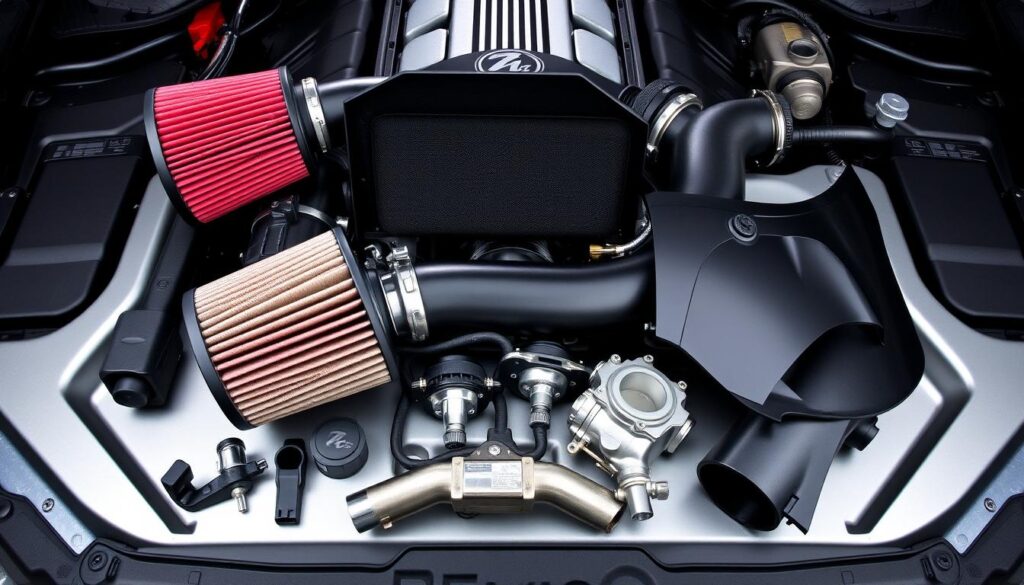
These parts work together to bring cooler, denser air to your engine. This can make your engine perform better and more efficiently. Keeping the air filter clean and checking connections helps your system work its best.
Benefits of Performance Air Intake Systems
Cold air intake systems make your car better. They give more power and better gas use. Car lovers like them a lot.
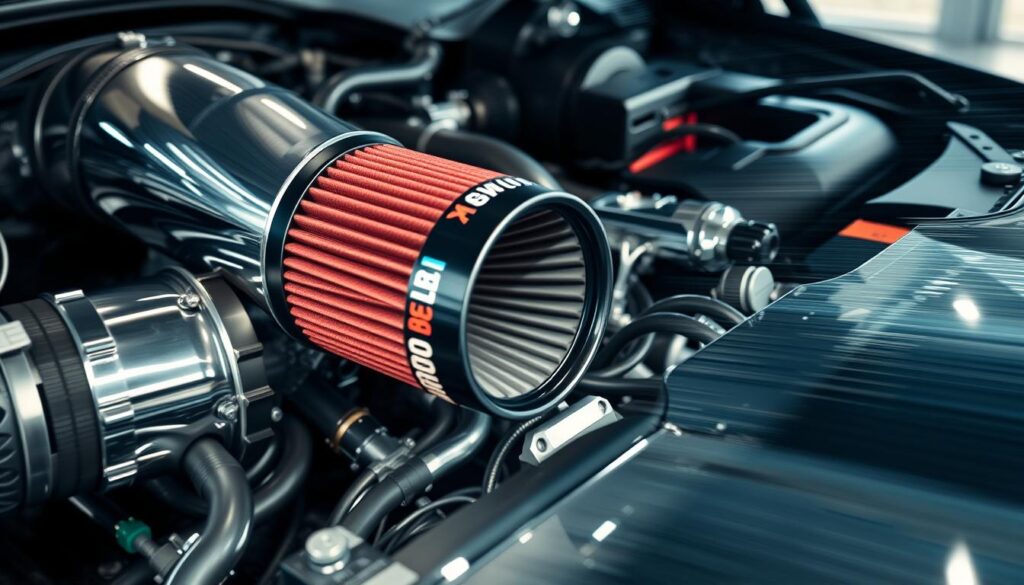
They can make your car stronger. You might see a 5 to 20 horsepower boost. This is because they bring cooler, denser air to your engine.
They also help your car use less gas. This is because they make your engine work better. Even a little bit helps save money.
And, they make your car sound better. You’ll hear a deeper, louder engine sound. It makes driving more fun.
| Benefit | Description |
|---|---|
| Power Increase | 5-20 horsepower gain |
| Fuel Efficiency | Slight improvement possible |
| Sound Enhancement | Deeper, more aggressive engine note |
| Maintenance | Cleaning required every 30,000-50,000 miles |
These systems are not very expensive. They cost between $150 and $500. They’re also simple to put in, needing just basic tools and a few hours.
But, remember there might be legal issues and warranty problems. Think about these before you make your car faster.
Horsepower and Torque Gains Explained
Understanding power gains from cold air intakes helps you make smart choices. These upgrades can make your engine stronger. But, the exact gains depend on many things.
Expected Power Increases
Cold air intakes usually give 5 to 20 horsepower and 10 to 25 pound-feet of torque. This is because they let your engine take in cooler, denser air more easily.
| Performance Metric | Typical Gain Range |
|---|---|
| Horsepower | 5 – 20 HP |
| Torque | 10 – 25 lb-ft |
Factors Affecting Performance Gains
The actual power increase depends on your car’s make, model, and engine size. Newer cars might see smaller gains because their stock intakes are already optimized. The type of intake system you pick also affects gains.
Real-World Performance Testing
Dyno testing is key to measuring power gains. Good companies do thorough tests to prove their products work. Engine tuning can also boost these gains, making your car run better.
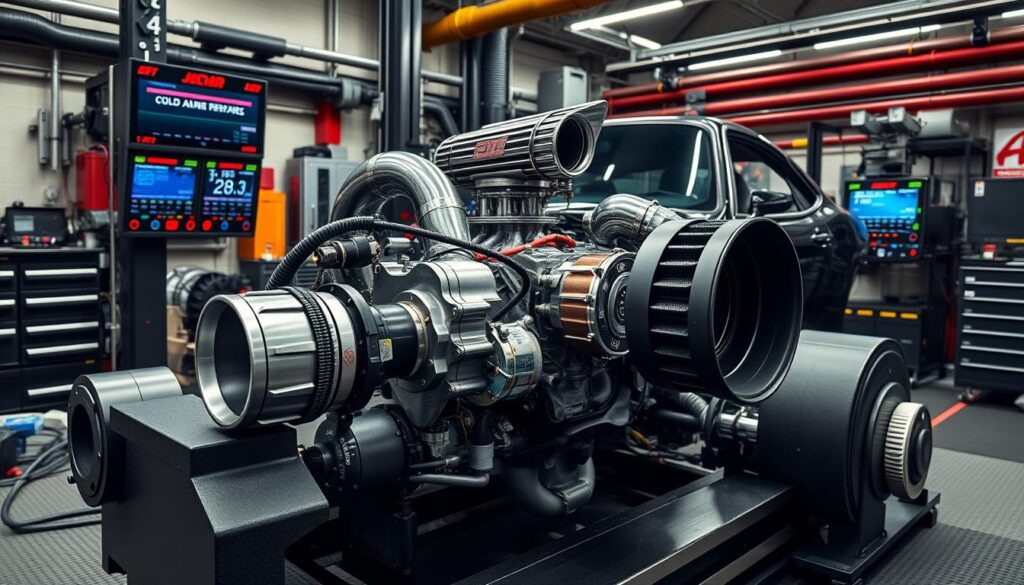
When looking for a cold air intake, check for dyno results. This info helps you know what performance boost to expect from better engine breathing.
Fuel Efficiency and Engine Response
Cold air intake systems make your car run better. They help your car use less fuel and respond faster. This is because they let more oxygen into the engine, making it burn fuel better.
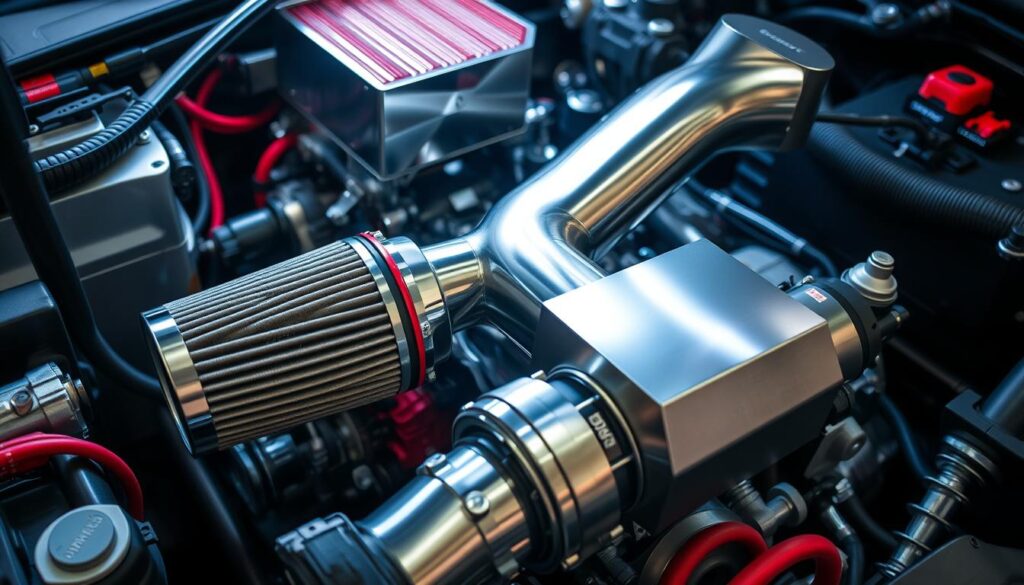
Many people say their car gets better gas mileage after getting a cold air intake. Some see a 10% boost in fuel efficiency. This is because the engine burns fuel more efficiently, leading to better performance and less emissions.
Another great thing about cold air intakes is how fast your car goes when you press the gas. It feels like your car goes faster right away. This is because of the extra airflow, making your engine react quicker.
| Performance Aspect | Potential Improvement |
|---|---|
| Fuel Efficiency | Up to 10% increase in MPG |
| Horsepower | Up to 10 extra horsepower |
| Throttle Response | Noticeably faster acceleration |
Remember, how much better your car gets can depend on your car and how you drive. Still, taking care of your car, like changing oil and keeping tires right, helps a lot.
Types of Cold Air Intake Designs
Cold air intake systems have different designs. Each design has its own benefits. The materials and air filters used can greatly affect your car’s performance.
Metal vs Plastic Intakes
Intakes can be made of metal or plastic. Metal ones are strong but heavy. Plastic ones are lighter and don’t hold heat as much.
Plastic is a favorite for high-performance intakes because of its lightness.
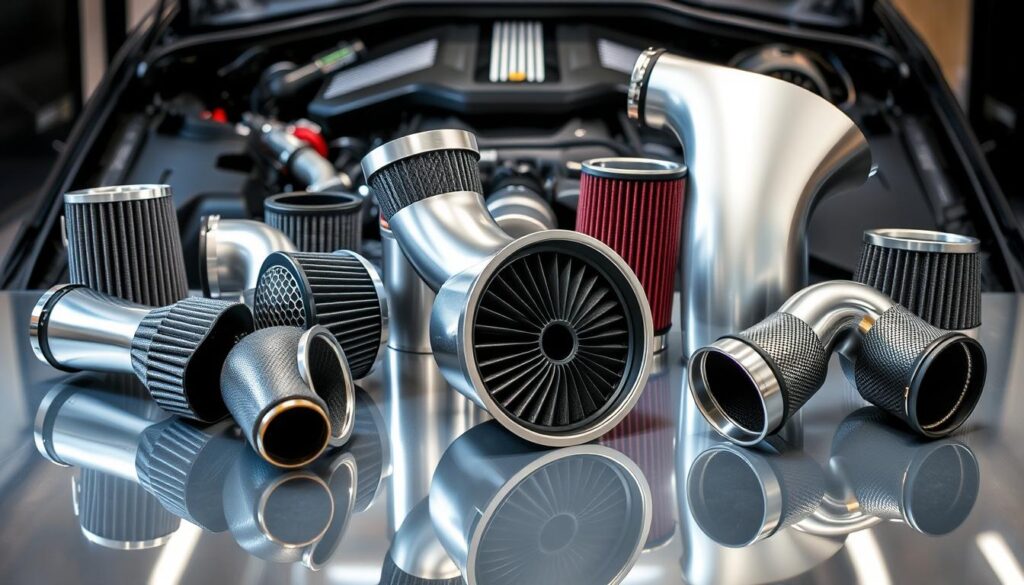
Short Ram vs True Cold Air Systems
Short ram intakes are small and easy to fit. True cold air systems are longer and pull air from cooler places. Both aim to improve performance.
But true cold air systems usually do better by getting cooler, denser air.
Filter Types and Materials
Air filters are key in intake design. Paper filters need to be replaced every 5,000-10,000 miles. Reusable filters need oil every 5,000 miles to work well.
Some systems use heat shields to keep the filter cool. This helps get better air for better performance.
| Intake Design | Materials | Maintenance |
|---|---|---|
| Short Ram | Plastic/Metal | Regular cleaning |
| True Cold Air | Plastic/Metal | Regular cleaning, check for water |
| Paper Filter | Paper | Replace every 5,000-10,000 miles |
| Reusable Filter | Cotton/Foam | Oil every 5,000 miles |
Installation and Maintenance Guide
Installing a cold air intake is easy and can make your engine run better. You can do it yourself with the right tools and some help. This way, you can improve your car’s intake system at home.
Tools Required for Installation
You’ll need simple tools like screwdrivers, pliers, and a socket set. Some intakes might need special tools. Always check the instructions before you start.
Step-by-Step Installation Process
First, disconnect the battery and take out the old air intake. Then, put in the new cold air intake parts as the instructions say. This usually means attaching the new filter and the intake tube to the throttle body.
Maintenance Requirements
Keeping your air filter clean is key for good performance. Change your filter every 60,000 miles for best airflow. If you have an oiled filter, clean and oil it when needed. Dry filters might need to be replaced instead of cleaned.
Keeping your intake system in good shape helps it last longer. One person drove 180,000 miles on a street rod with little upkeep. By following these tips, you can make your engine run better for many years.
Compatibility and Vehicle Considerations
Choosing the right cold air intake for your car is important. You need to think about how it fits and what engine it has. Your car’s make, model, and year matter a lot. Knowing what your car needs helps you make a good choice.
There are different intake systems for different cars. Short ram intakes are cheaper and easier to install. Long tube intakes give more horsepower. Think about what you want most when picking between metal and plastic tubes.
Use online tools or talk to experts to find the right intake. They can help you pick the best one for your car. Some intakes might need extra tuning to work right with your engine.
| Intake Type | Installation Difficulty | Performance Gain | Cost |
|---|---|---|---|
| Short Ram | Easy | Moderate | Low |
| Cold Air | Moderate | High | Medium |
| Performance | Complex | Maximum | High |
Thinking about these things helps you pick the best intake. It will make your car run better without hurting its warranty or how it works.
Legal and Warranty Implications
When you think about getting a cold air intake, you need to know the legal stuff. Things like emissions rules, warranty issues, and EPA rules are important.
State Regulations and Emissions
States have different rules about emissions. Make sure your cold air intake fits these rules. The Clean Air Act has two warranties for emissions. These warranties can be lost if aftermarket parts cause problems.
Impact on Vehicle Warranty
The Magnuson-Moss Warranty Act helps if you use aftermarket parts. It says you can’t lose your warranty just because of aftermarket parts. But, if these parts mess up your car, you might lose your warranty. Always check your warranty carefully.
EPA Compliance Requirements
EPA rules are key when you change your car. Cars must meet strict emissions standards. Even if you use aftermarket parts, they can’t mess with emissions systems.
| Warranty Type | Coverage | Duration |
|---|---|---|
| Production Warranty | Meets emissions at sale | Varies |
| Performance Warranty | Ongoing emissions compliance | Part-specific |
| AEM Intake System | Lifetime for original buyer | Non-transferable |
Remember, making your car better is good. But, you must follow the law. Always make sure you’re following the rules to keep your warranty and avoid legal trouble.
Conclusion
Cold air intake systems give your car a big performance upgrade. They can make your car go 5-10% faster. This makes driving a lot more fun.
These systems also make your car use less fuel. This means you can drive farther on a tank of gas. Some people say their car goes from 12.1 to 10 seconds faster after they put one in.
When picking a cold air intake, think about the size of the intake tube and the filter. Some types, like Randall-style, might make your car go even faster. Always clean the air filter to keep your car running well. A cold air intake is a smart way to make your car better and more fun to drive.
FAQ
What is a cold air intake?
How much horsepower can I gain with a cold air intake?
Can a cold air intake improve fuel efficiency?
Are cold air intakes easy to install?
Will installing a cold air intake void my vehicle’s warranty?
Are cold air intakes legal in all states?
What’s the difference between a short ram intake and a true cold air intake?
How often do I need to clean or replace the air filter in a cold air intake?
Can a cold air intake work with a turbocharger?
Will a cold air intake change the sound of my engine?
Last Updated: October 30, 2024

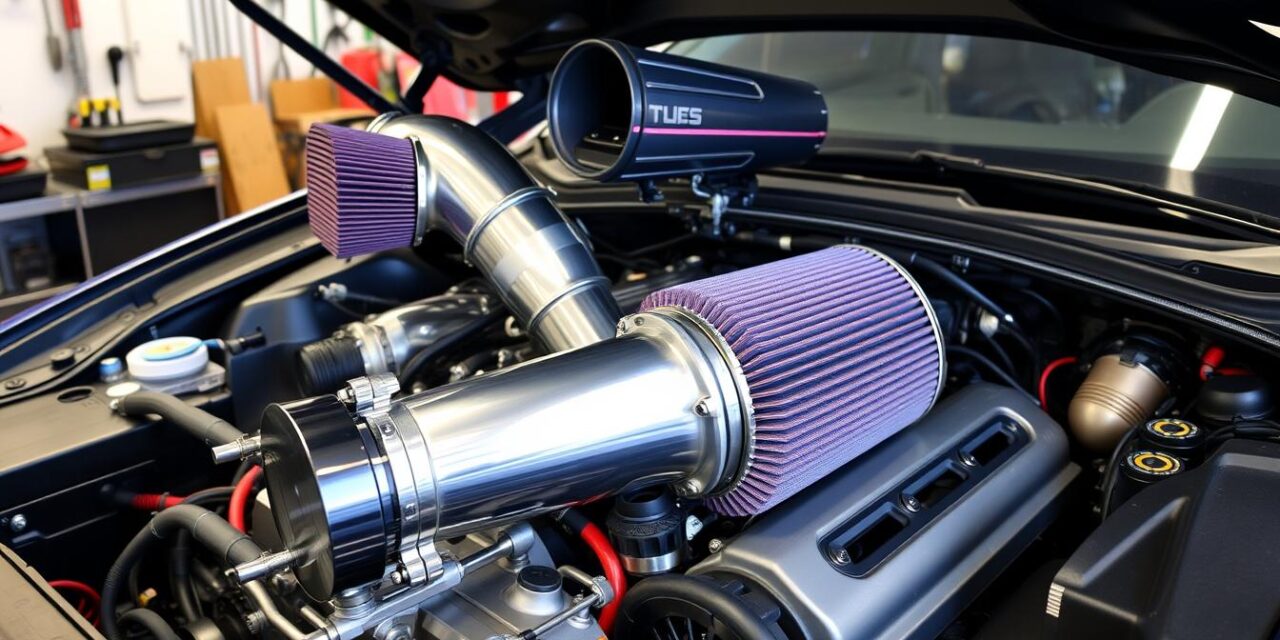


Recent Comments